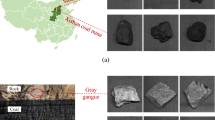Abstract
This paper proposes a modified YOLOv4 model, named GYOLO, for coal gangue recognition with the aim of reducing model parameters, improving calculation speed, and reducing equipment requirements. To achieve this, the paper optimizes the feature extraction network structure by using linear operation instead of traditional convolution to obtain redundant feature maps, thus reducing the number of parameters by 29.7%. A feature fusion network structure is also reconstructed to strengthen the model’s use of feature information, further explore the dependence of each channel feature, and make better use of feature information. The ablation experiment is designed to verify the effect of each improvement. The image is blurred to improve the difficulty of target detection and test the robustness of the GYOLO model. The generative adversarial network is trained with a small amount of coal gangue data, and then a large amount of virtual data is obtained by using the generative adversarial neural network. The GYOLO model is trained by transfer learning, which reduces the dependence of the model on real data. The GYOLO algorithm is compared with a variety of excellent target detection algorithms to analyze the performance of the algorithm. It is verified that the accuracy of the proposed method is 97.08%, which is 2.3% higher than that of the original model, the amount of parameters is reduced by 19.6%, and the amount of data required is reduced by 57.3%. The balance between data volume, parameter quantity and model performance is further realized.












Similar content being viewed by others
Data availability
The datasets generated and analyzed during the current study are available from the corresponding author on reasonable request.
References
Alfarzaeai, M.S., Niu, Q., Zhao, J., Eshaq, R.: Coal/gangue recognition using convolutional neural networks and thermal images. IEEE Access 8, 76780–76789 (2020)
Bai, F.Y., Fan, M.Q., Yang, H.L., Dong, L.P.: Fast recognition using convolutional neural network for the coal particle density range based on images captured under multiple light sources. Int. J. Min. Sci. Technol. 31(6), 1053–1061 (2021)
Dou, D., Wu, W., YANG, J., Zhang, Y.: Classification of coal and gangue under multiple surface conditions via machine vision and relief-SVM. Powder Technol. 356, 1024–1028 (2019)
Dwivedi, N., et al.: Employing data generation for visual weapon identification using Convolutional neural networks. Multimedia Syst. 28(1), 347 (2022)
Gilanie, G., et al.: RiceNet: convolutional neural networks-based model to classify Pakistani grown rice seed types. Multimedia Syst. 27(5), 867 (2021)
Hu, Y.C., et al.: Video-based driver action recognition via hybrid spatial-temporal deep learning framework. Multimedia Syst. 27(3), 483 (2021)
Hu, F., Zhou, M.R., Yan, P.C., Bian, K.: Multispectral imaging: a new solution for identification of coal and gangue. IEEE Access 7, 169697–169704 (2019)
Han, K., Wang, Y., Tian, Q., Guo, J.Y., Xu, C.J.: GhostNet: more features from cheap operations, pp. 1577–1586. IEEE Computer Society, DC USA (2019)
Hu, F., Bian, K.: Accurate identification strategy of coal and gangue using infrared imaging technology combined with convolutional neural network. IEEE Access 10, 8758–8766 (2022)
Eshaq, R., Hu, E.Y., Qaid, H., Zhang, Y., Liu, T.G.: Using deep convolutional neural networks and infrared thermography to identify coal quality and gangue. IEEE Access 9, 147315–147327 (2021)
Li, D., Wu, D., Xu, F., Lai, J., Shao, L.: Literature overview of Chinese research in the field of better coal utilization. J. Clean. Prod. 185, 959–980 (2018)
Lei, H., Wang, S., Guo, Y.C., Cheng, G.: Multi-scale coal and gangue dual-energy X-ray image concave point detection and segmentation algorithm. Measurement 196, 111041 (2022)
Li, D., Zhang, Z.X., Xu, Z., Xu, L., Meng, G.Y.: An image-based hierarchical deep learning framework for coal and gangue detection. IEEE Access 7, 184686–184699 (2019)
Li, D., Wang, G., Zhang, Y., Wang, S.: Coal gangue detection and recognition algorithm based on deformable convolution YOLOv3. IET Image Proc. 16(1), 134–144 (2022)
Liu, Q., Li, J.G., Li, Y.S., Gao, M.: Recognition methods for coal and coal gangue based on deep learning. IEEE Access 9, 77599–77610 (2021)
Muhammad, I., Akhtar, J., Sheikh, N., Munir, S.: Reverse flotation of cut-of-grade of Lakhra coal. Energy Sourc Part A Recov Utilizat Environ Ef-fects 39(20), 1999–2005 (2017)
Ma, G., Wang, X.S., Liu, J., Chen, W., Niu, Q.: Intelligent detection of foreign matter in coal mine transportation belt based on convolution neural network. Sci Program (2022). https://doi.org/10.1038/s41598-017-18625-y
Pan, H., Shi, Y.H., Lei, X., Wang, Z., Xin, F.: Fast identification model for coal and gangue based on the improved tiny YOLOv3. J. Real-Time Image Proc. 19(3), 687–701 (2022)
Pu, Y., Apel, D., Szmigiel, A., Chen, J.: Image recognition of coal and coal gangue using a convolutional neural network and transfer learning. Energies 12(9), 1735–1745 (2019)
Ran, Z., Pan, Y., Liu, W.: Co-disposal of coal gangue and red mud for prevention of acid mine drainage generation from self-heating gangue dumps. Minerals 11(6) (2020)
Radford A, Metz L, Chintala S (2015) Unsupervised representation learning with deep convolutional generative adversarial networks. International Conference on Learning Representations.
Wu, D., Wang, Y., Wang, M., Wei, C., Hu, G., He, X., Fu, W.: Basic characteristics of coal gangue in a small-scale mining site and risk assessment of radioactive elements for the surrounding soils. Minerals. 11(6), 647 (2021)
Wang, X., Wang, S., Guo, Y., Hu, K., Wang, W.: Dielectric and geometric feature extraction and recognition method of coal and gangue based on VMD-SVM. Powder Technol 7, 241–250 (2021)
Wang, B., Huang, H., Dou, D., Qiu, Z.: Detection of coal content in gangue via image analysis and particle swarm optimization-support vector machine. Int. J. Coal Prep. Util. 42(7), 1915–1924 (2021)
Wang, Y., Wang, Y.J., Dang, L.: Video detection of foreign objects on the surface of belt conveyor underground coal mine based on improved SSD. Journal of Ambient Intelligence and Humanized Computing (2020). https://doi.org/10.1007/s12652-020-02495-w
Wang, L., Wang, X.W., Li, B., Wei, D.L.: A data expansion strategy for improving coal-gangue detection. Int J Coal Preparat Utilizat (2021). https://doi.org/10.1080/19392699.2022.2096016
Xing, J., Zhao, Z., Wang, Y., Nie, L., Du, X.: Coal and gangue identification method based on the intensity image of lidar and DenseNet. Appl. Opt. 60(22), 6566–6572 (2021)
Xu, G., Bu, X., Mao, Y., Ni, C., Peng, Y., Xie, G.: Combined column and cell flotation process for improving clean coal quality: Laboratory-scale and industry-scale studies. Energy Sourc. Part A Recov. Utilizat. Environ-mental Eff. 42(21), 2678–2687 (2020)
Yang, D., Li, J., Du, C., Zheng, K., Liu, S.: Particle size distribution of coal and gangue after impact-crush separation. J. Cent. South Univ. 24(6), 1252–1262 (2017)
Yang, D., Li, J., Zheng, K., Du, C., Liu, S.: Impact-crush separation characteristics of coal and gangue. Int. J. Coal Prep. Util. 38(3), 127–134 (2018)
Zhao, Y., Wang, S., Cheng, G., He, L.: Study on coal and gangue recognition method based on the combination of X-ray transmission and diffraction principle. Energy Sourc. Part A Recov. Utilizat. Environ. Eff. 44(4), 9716–9728 (2022)
Zhang Y, Zhu H, Zhu J, Ou Z, Shen T, Sun J, Feng A 2021 Experimental study on separation of lumpish coal and gangue using X-ray. Energy Sources, Part A: Recovery, Utilization, and Environ-mental Effects.
Zhang, N., Liu, C.: Radiation characteristics of natural gamma-ray from coal and gangue for recognition in top coal caving. Sci. Rep. 8(1), 190 (2018)
Zhang, Z., Yang, J.: Online analysis of coal ash content on a moving conveyor belt by machine vision. J. Coal Prepara. Utilizat. 37(2), 100–111 (2022)
Zhang, Y., Wang, J., Yu, Z., Zhao, S., Bei, G.: Research on intelligent detection of coal gangue based on deep learning. Measurement 198, 111415 (2022)
Acknowledgements
This work is supported by National Natural Science Foundation of China (51804207, 51875386). We thank the anonymous reviewer for pointing out the issues on the manuscript.
Funding
Xuewen Wang reports financial support was provided by National Natural Science Foundation of China (51875386). Bo Li reports financial support was provided by National Natural Science Foundation of China (51804207).
Author information
Authors and Affiliations
Contributions
Dailiang Wei is responsible for the improvement of the algorithm structure, Juanli Li and Dailiang Wei are responsible for the preparation of the paper, Bo Li, Xin Wang,Siyuan Chen,Xuewen Wang and Luyao Wang are responsible for the experiment, and Wang Luyao is responsible for drawing the pictures in the paper
Corresponding author
Ethics declarations
Conflict of interest
The authors declare that they have no known competing financial interests or personal relationships that could have appeared to influence the work reported in this paper.
Additional information
Handling editor: Dr. An-An Liu.
Publisher's Note
Springer Nature remains neutral with regard to jurisdictional claims in published maps and institutional affiliations.
Rights and permissions
Springer Nature or its licensor (e.g. a society or other partner) holds exclusive rights to this article under a publishing agreement with the author(s) or other rightsholder(s); author self-archiving of the accepted manuscript version of this article is solely governed by the terms of such publishing agreement and applicable law.
About this article
Cite this article
Wei, D., Li, J., Li, B. et al. A fast recognition method for coal gangue image processing. Multimedia Systems 29, 2323–2335 (2023). https://doi.org/10.1007/s00530-023-01109-7
Received:
Accepted:
Published:
Issue Date:
DOI: https://doi.org/10.1007/s00530-023-01109-7




